The carbon cycle is one of the important biogeochemical cycles of the Earth system. The rise in atmospheric CO2 concentrations since the industrial revolution and the associated warming facts of the last hundred years have made the resolution of CO2 emissions and income pathways and dynamics a frontier scientific issue. The traditional view is that lakes are a source of atmospheric CO2, but a growing number of studies have demonstrated that lakes may be a carbon sink and their carbon sequestration role may be underestimated. The Batangilin Desert is the second largest desert in China and has the largest sand dunes in the world in terms of height. The hinterland of this desert and its outer edges have about 110 perennial waterlogged lakes, most of which are saline lakes, and there is a clear distribution of calcium blooms in or around the lakes, indicating that the carbon cycling process in the lakes is very active. Due to the harsh natural conditions and poor transportation and communication, the balance of emissions and income of CO2 in the desert lake complex is unclear, and the CO2 exchange mechanism at the lake-air interface is even less understood.
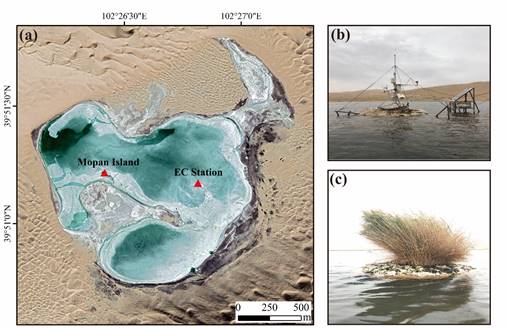
Figure 1. (a) Location of Yindeltu and observation sampling points; (b) Eddy covariance system of lake-surface; (c) Mill Island
In order to quantify the carbon balance pathways and their dynamics in the desert region, Professor Wang Nai'ang's research team installed an eddy covariance system (EC) (Figure 1) on Calcarea Island in the center of Yindeltu Lake in the hinterland of the Batangilin Desert in 2012, mainly to monitor the variation of CO2 fluxes at different time scales, with a view to revealing the source/sink nature, main influencing factors and mechanisms of CO2 fluxes. It was found that the Yindeltu was a net CO2 sink during the observation period, with annual net CO2 flux uptake ranging from -77.6 to -108.1 g C m-2a-1and a significant carbon sequestration effect of the lake. From the average state of the carbon sink rate in the Yindeltu, it can be estimated that the entire lake in the Batangilin Desert absorbs about 1.91×103t of CO2 per year, reducing the rate of increase of CO2 in the atmosphere and contributing to the mitigation of global warming.
The main meteorological factors controlling CO2 fluxes in the Yndeltu vary on different time scales (Figure. 2). On the half-hourly scale, saturated water-air pressure difference (VPD) and relative humidity (RH) have a strong influence on CO2 fluxes and a negative correlation with RH. Except for 2015, CO2 fluxes show significant linear relationships with air temperature (Ta), water surface temperature (Ts), net radiation (Rn) and saturated water-air pressure difference (VPD) on the daily scale. On the monthly scale, there was a significant positive correlation between saturated water-air pressure difference (VPD) and CO2 flux, while the role of relative humidity (RH) and the lake level was weaker. On the annual scale, the relationship between CO2 fluxes and meteorological factors is not significant. The results of the calcrete and spring δ13C tests at the eddy station and Mill Island indicate that biology has little influence in the process of fractionation. The main mechanism controlling CO2 uptake and release from Yindeltu is inorganic processes, dominated by temperature-driven pH, regulating the exchange of CO2 at the lake-gas interface (Figures 3 and 4).
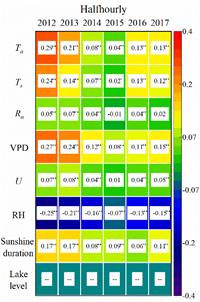
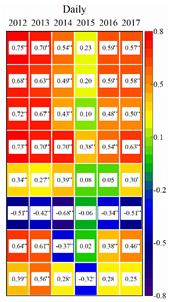
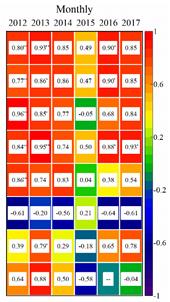
Figure 2.Relationships between CO2 fluxes and various meteorological factors on different time scales, 2012-2017
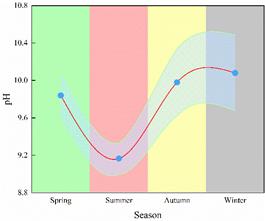
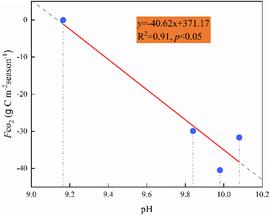
Figure 3.Seasonal mean and standard deviation of pH Figure 4.Relationship between CO2 fluxes and pH
The above study clarifies the characteristics of CO2 changes in desert lakes and the influence mechanism, filling a gap in the study of the carbon cycle in desert lakes in China. The results provide new ideas for finding the pathways of global lost carbon and formulating adaptation countermeasures to global climate change and also provide regional data support for the formulation of energy-saving and carbon-neutral policies. The research results were published in Ecological Indicators under the title 'Variation Characteristics and Influencing Mechanism of CO2 Flux from Lakes in the Badain Jaran Desert: A Case Study of Yindeer Lake', with Yang Ping, a 2018 PhD student in Earth System Science of Lanzhou University, as the first author and Professor Wang Nai'ang from the Center for Glacier and Desert Research as the corresponding author. The research was supported by the Key Project of the National Natural Science Foundation of China (41530745) and the National Natural Science Foundation of China (41871021).
Article link:https://doi.org/10.1016/j.ecolind.2021.107731